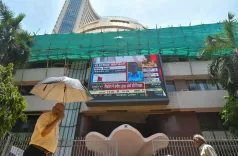Will the Government Launch a Centralized Survey and Re-Survey of Lands?

Synopsis
Key Takeaways
- Centrally coordinated land surveys will address outdated records.
- Technology, including drones and AI, will streamline the process.
- Integration of Aadhaar numbers is crucial for transparent land governance.
- The initiative has a budget of Rs 3,000 crore for the first phase.
- Only 4 percent of villages have completed the survey so far.
New Delhi, May 15 (NationPress) On Thursday, the government announced plans to initiate a centrally coordinated and technology-driven survey and re-survey of lands, addressing issues stemming from inaccurate and outdated land records that are leading to disputes.
The centrally-sponsored initiative will utilize advanced technology, including aerial surveys conducted by drones and aircraft, at just 10 percent of the costs associated with traditional surveying methods, as stated by Dr. Chandra Sekhar Pemmasani, Minister of State for Rural Development and Communications.
This scheme will leverage AI, GIS, and high-accuracy equipment. It will require cooperation from states for ground-truthing and validations while the central government will provide policy, funding, and a technological framework.
The programme will unfold in five phases, beginning with a focus on 300,000 square kilometers of rural agricultural land over a two-year span, with an initial budget of Rs 3,000 crore for Phase I, the minister noted.
He also encouraged states to finalize the integration of Aadhaar numbers with Records of Rights (RoRs), a reform aimed at linking land ownership with unique digital identities, thereby reducing impersonation and ensuring that benefits such as Agristack, PM-KISAN, and crop insurance reach the right individuals.
Speaking at the national workshop on survey/re-survey under the Digital India Land Records Modernization Programme (DILRMP) in Guntur, Andhra Pradesh, which was attended by senior officials from both the Centre and states, as well as experts and field practitioners, the minister emphasized that reforms like re-surveying, digitization, paperless offices, court case management, and Aadhaar integration will contribute to a comprehensive and transparent land governance ecosystem.
He remarked that when land records align with actual conditions, it unlocks the economic potential of land—enabling banks to extend credit confidently, allowing businesses to invest with assurance, and helping farmers access agricultural support.
“If we aspire for rapid highways, smart cities, secure housing, and sustainable agriculture, we must begin from the ground up—quite literally,” he added.
Despite significant advances under the DILRMP, a critical pending element—the survey and re-survey—has only been completed in 4 percent of villages thus far, as this task requires extensive administrative coordination, technological input, and public engagement, he mentioned.
“Numerous states have yet to perform map-based subdivisions or maintain spatial records in alignment with textual updates, rendering current cadastral maps obsolete. Our experience indicates that without strong political will and effective coordination, surveys lose momentum and remain incomplete,” the minister concluded.









